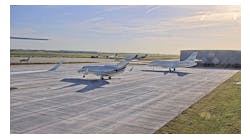The Pullman-Moscow Regional Airport enjoyed a January without a visibility-related flight cancellation, and the airport executive director attributes that success to new technology installed last year.
Executive Director Tony Bean said the airport did not see a cancellation because of low visibility for its Alaska Airline flights to and from Seattle in 2020 until Friday, when heavy fog rolled onto the Palouse.
Bean said a visibility cancellation means the minimum visibility requirements could not be met for the pilot to safely land on the runway.
Low visibility is among the most common reasons for a flight to be canceled in Pullman. They can also be canceled because of mechanical issues, crew issues or cancellations in Seattle, he said. The airport saw a dozen cancellations this year for these other reasons, Bean said.
He said the Pullman-Moscow Regional Airport recorded seven cancellations because of visibility in December, a month when it typically sees about a dozen such cancellations, Bean said.
Bean credited the improvement to the new runway and $5 million instrument landing system installed last year.
In January 2019, the airport recorded 18 total cancellations because of poor visibility.
“Now with the technology and instrumentation, it’s a significant improvement,” he said.
The airport plans to gather overall data on winter flights in March, but typically about 8 percent of scheduled flights are canceled because of visibility issues in the winter months, Bean said. He expects those cancellations to be less than 2 percent this winter.
He said that given the severity of the winter weather on the Palouse this year, the airport without the instrument landing system would have “easily canceled 80 flights.”
Bean said the total number of passengers who boarded a plane in December at the airport exceeded 8,000, which is a record for that month. A total of 69,555 people boarded planes in 2019, which is also a record.
Bean also spoke about the discrepancy in cancellations reported by Pullman-Moscow Regional Airport versus what the Lewiston-Nez Perce Regional Airport reported.
According to a Jan. 26 Lewiston Tribune report, Lewiston airport officials claimed 578 flights were scheduled to arrive or depart from Pullman from Nov. 17 through Jan. 15, and 55 of those, or 10 percent, were canceled or diverted to other airports. This is 1 percent higher than the 2019 cancellation numbers, according to Lewiston airport officials.
Bean, meanwhile, claimed 46, or 8 percent, were unable to land at or depart from the Pullman-Moscow Regional Airport during that time period. That compares with 64, or 14 percent, that were scrubbed between Nov. 17, 2018, through Jan. 15, 2019, when 458 fights were scheduled on the same routes, Bean said.
Bean on Monday told the Daily News that Lewiston’s numbers are misleading because they are based on raw data. For example, they do not take into account that some days, such as holidays, the Pullman-Moscow Regional Airport has a reduced flight schedule. He said Lewiston’s numbers count those missing flights as cancellations.
As winter turns to spring, passengers can expect a new flight schedule that includes two overnight arrivals and a 7:20 a.m. departure.
Starting March 23, Alaska departures most days will be scheduled for 5 a.m., 7:20 a.m., 11:35 a.m., 3:25 p.m. and 7:15 p.m.
Arrivals will take place 10:55 a.m., 2:45 p.m., 6:33 p.m., 10:28 p.m. and 12:18 a.m.
This year, construction crews will also begin constructing the new taxiway. It is expected to be completed in 2021, and the runway will not have to be closed during construction, Bean said.
Anthony Kuipers can be reached at (208) 883-4640, or by email to [email protected].
———
©2020 the Moscow-Pullman Daily News (Moscow, Idaho)
Visit the Moscow-Pullman Daily News (Moscow, Idaho) at www.dnews.com
Distributed by Tribune Content Agency, LLC.




